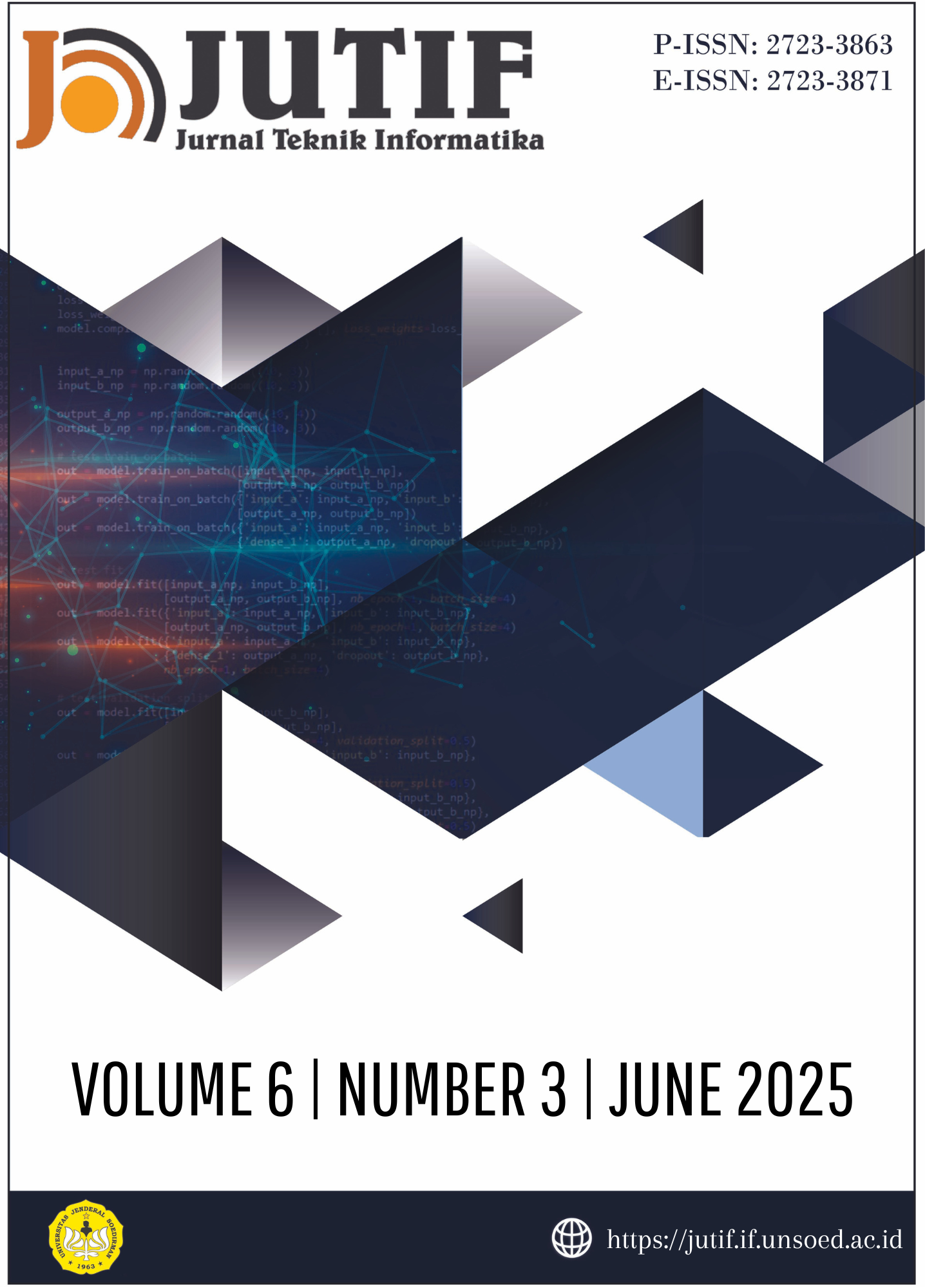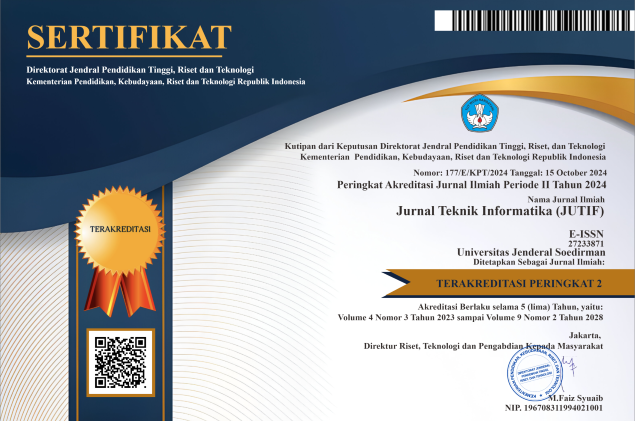Optimal Phase Selection Of Single-Phase Appliances In Buildings Using String-Coded Genetic Algorithm
DOI:
https://doi.org/10.52436/1.jutif.2025.6.3.4603Keywords:
Building energy management, Genetic Algorithm, Low voltage network, Single-phase appliance, Unbalanced loadAbstract
Phase imbalance in buildings, primarily caused by single-phase loads and generation, leads to increased neutral current, voltage imbalance, reduced energy efficiency, and potential equipment damage. To address these challenges, an optimal phase selection method is proposed for single-phase loads and generation. This method integrates integer programming with a string-coded genetic algorithm (GA). The GA employs string encoding to represent phase connections. Initially, a Mixed Integer Programming (MIP) solver identifies an initial solution, which is subsequently transformed into a string to initialize the GA’s genes. Subsequently, the GA executes standard operations such as mutation, crossover, evaluation, and selection. Case studies demonstrate the efficacy of this method in achieving substantial load balancing. Notably, the identification of multiple solutions with identical objective function values renders this approach suitable for smart buildings equipped with energy management systems that participate in ancillary services between low-voltage and medium-voltage networks. This research pertains to the domains of computer science, power engineering, and energy informatics.
Downloads
References
K. Ma, L. Fang, and W. Kong, “Review of distribution network phase unbalance: Scale, causes, consequences, solutions, and future research directions,” CSEE Journal of Power and Energy Systems, vol. 6, no. 3, pp. 479–488, Sep. 2020, doi: 10.17775/CSEEJPES.2019.03280.
M. A. Rahman and J. Choudhary, “Smart load balancing system for 3-phase 4 wire distribution system,” Engineering Research Express, vol. 4, no. 4, p. 045043, Jan. 2023, doi: 10.1088/2631-8695/acae1f.
R. A. Mahmoud, “Experimental performance verification of an intelligent detection and assessment scheme for disturbances and imbalances of three-phase synchronous machine output using coherence estimators,” Scientific Reports, vol. 14, no. 1, p. 26278, Nov. 2024, doi: 10.1038/s41598-024-76343-8.
Heidari-Akhijahani Adel, Safdarian Amir, and Lehtonen Matti, “Unbalance mitigation by optimal placement of static transfer switches in low voltage distribution feeders,” IET Generation, Transmission & Distribution, vol. 14, no. 20, pp. 4612–4621, Oct. 2020, doi: 10.1049/iet-gtd.2019.1467.
S. B. Pandu et al., “Power Quality Enhancement in Sensitive Local Distribution Grid Using Interval Type-II Fuzzy Logic Controlled DSTATCOM,” IEEE Access, vol. 9, pp. 59888–59899, 2021, doi: 10.1109/ACCESS.2021.3072865.
B. Liu, K. Meng, Z. Y. Dong, P. K. C. Wong, and T. Ting, “Unbalance mitigation via phase-switching device and static var compensator in low-voltage distribution network,” IEEE Transactions on Power Systems, vol. 35, no. 6, pp. 4856–4869, Nov. 2020, doi: 10.1109/TPWRS.2020.2998144.
S. Liu et al., “Bi-level optimal placement model of phase switch devices for mitigating three-phase unbalance in low-voltage areas,” IEEE Transactions on Power Systems, vol. 37, no. 4, pp. 3149–3152, Jul. 2022, doi: 10.1109/TPWRS.2022.3156438.
H. Saber, M. Ehsan, M. Moeini-Aghtaie, H. Ranjbar, and M. Lehtonen, “A User-Friendly Transactive Coordination Model for Residential Prosumers Considering Voltage Unbalance in Distribution Networks,” IEEE Transactions on Industrial Informatics, vol. 18, no. 9, pp. 5748–5759, Sep. 2022, doi: 10.1109/TII.2022.3141784.
P. N. Zanjani, S. Javadi, M. H. Aliabadi, and G. B. Gharehpetian, “A Novel Approach for Mitigating Electrical Losses and Current Unbalance in Low Voltage Distribution Networks,” IET Generation, Transmission & Distribution, vol. 19, no. 1, p. e70072, Jan. 2025, doi: 10.1049/gtd2.70072.
S. Chen, Z. Guo, Z. Yang, Y. Xu, and R. S. Cheng, “A game theoretic approach to phase balancing by plug-in electric vehicles in the smart grid,” IEEE Transactions on Power Systems, vol. 35, no. 3, pp. 2232–2244, 2020, doi: 10.1109/tpwrs.2019.2946178.
H. Li, Z. Wan, and H. He, “Real-Time Residential Demand Response,” IEEE Transactions on Smart Grid, vol. 11, no. 5, pp. 4144–4154, Sep. 2020, doi: 10.1109/TSG.2020.2978061.
S. Limmer, F. Lezama, J. Soares, and Z. Vale, “Coordination of Home Appliances for Demand Response: An Improved Optimization Model and Approach,” IEEE Access, vol. 9, pp. 146183–146194, 2021, doi: 10.1109/ACCESS.2021.3122928.
U. Pati and K. D. Mistry, “Cyber-Resilient Trading for Sustainable Energy Management: A Three-Phase Demand-Side Management Solution with Integrated Deep Learning-Based Renewable Energy Forecasting,” IEEE Transactions on Industry Applications, vol. 60, no. 2, pp. 2532–2541, Apr. 2024, doi: 10.1109/TIA.2023.3332061.
O. Pereira, J. Quiros-Tortos, and G. Valverde, “Phase rebalancing of distribution circuits dominated by single-phase loads,” IEEE Transactions on Power Systems, pp. 1–1, 2021, doi: 10.1109/TPWRS.2021.3076629.
B. Liu, K. Meng, Z. Dong, P. K. C. Wong, and X. Li, “Load balancing in low-voltage distribution network via phase reconfiguration: An efficient sensitivity-based approach,” IEEE Transactions on Power Delivery, pp. 1–1, 2020, doi: 10.1109/TPWRD.2020.3022061.
Y. Zhang and X. Sun, “Phase reassignment strategy and load phase-swapping device for three-phase unbalance in the power distribution area,” Electric Power Systems Research, vol. 235, p. 110564, Oct. 2024, doi: 10.1016/j.epsr.2024.110564.
L. Fang, K. Ma, F. Li, and F. Xue, “A new incentive scheme to incentivize flexible customers for phase balancing,” CSEE Journal of Power and Energy Systems, pp. 1–13, 2022, doi: 10.17775/CSEEJPES.2021.07810.
I. -I. Avramidis, F. Capitanescu, V. A. Evangelopoulos, P. S. Georgilakis, and G. Deconinck, “In Pursuit of New Real-Time Ancillary Services Providers: Hidden Opportunities in Low Voltage Networks and Sustainable Buildings,” IEEE Transactions on Smart Grid, vol. 13, no. 1, pp. 429–442, Jan. 2022, doi: 10.1109/TSG.2021.3112925.
T. Ono, A. Hagishima, and J. Tanimoto, “Evaluation of potential for peak demand reduction of residential buildings by household appliances with demand response,” Electronics and Communications in Japan, vol. 105, no. 4, p. e12379, Dec. 2022, doi: 10.1002/ecj.12379.
L. Zhang, Y. Tang, T. Zhou, C. Tang, H. Liang, and J. Zhang, “Research on flexible smart home appliance load participating in demand side response based on power direct control technology,” Energy Reports, vol. 8, pp. 424–434, Jul. 2022, doi: 10.1016/j.egyr.2022.01.219.
C. Chen, J. Wang, Y. Heo, and S. Kishore, “MPC-Based Appliance Scheduling for Residential Building Energy Management Controller,” IEEE Transactions on Smart Grid, vol. 4, no. 3, pp. 1401–1410, Sep. 2013, doi: 10.1109/TSG.2013.2265239.
J. Wang et al., “A Novel Double-Layer Strategy for Three-Phase Imbalance Treatment Using an Improved Genetic Algorithm Based on MIT-LXPM,” IEEE Transactions on Industry Applications, vol. 59, no. 6, pp. 7404–7416, Dec. 2023, doi: 10.1109/TIA.2023.3305582.
O. D. Montoya, A. Molina-Cabrera, L. F. Grisales-Noreña, R. A. Hincapié, and M. Granada, “Improved Genetic Algorithm for Phase-Balancing in Three-Phase Distribution Networks: A Master-Slave Optimization Approach,” Computation, vol. 9, no. 6, 2021, doi: 10.3390/computation9060067.
G. Bao and S. Ke, “Load Transfer Device for Solving a Three-Phase Unbalance Problem Under a Low-Voltage Distribution Network,” Energies, vol. 12, no. 15, 2019, doi: 10.3390/en12152842.
S. Liu et al., “Practical method for mitigating three-phase unbalance based on data-driven user phase identification,” IEEE Transactions on Power Systems, vol. 35, no. 2, pp. 1653–1656, Mar. 2020, doi: 10.1109/TPWRS.2020.2965770.
Q. Huangfu and J. A. J. Hall, “Parallelizing the dual revised simplex method,” Mathematical Programming Computation, vol. 10, no. 1, pp. 119–142, Mar. 2018, doi: 10.1007/s12532-017-0130-5.
T. Kriechbaumer and H.-A. Jacobsen, “BLOND, a building-level office environment dataset of typical electrical appliances,” Scientific Data, vol. 5, no. 1, p. 180048, 2018, doi: 10.1038/sdata.2018.48.
M. Pipattanasomporn et al., “CU-BEMS, smart building electricity consumption and indoor environmental sensor datasets,” Scientific Data, vol. 7, no. 1, p. 241, 2020, doi: 10.1038/s41597-020-00582-3.
M. S. Javadi et al., “Self-scheduling model for home energy management systems considering the end-users discomfort index within price-based demand response programs,” Sustainable Cities and Society, vol. 68, p. 102792, May 2021, doi: 10.1016/j.scs.2021.102792.
B. Park, S. Kwon, and B. Oh, “Standby Power Reduction of Home Appliance by the i-HEMS System Using Supervised Learning Techniques,” Energies, vol. 17, no. 10, 2024, doi: 10.3390/en17102404.
B. Berger, M. S. Waterman, and Y. W. Yu, “Levenshtein distance, sequence comparison and biological database search,” IEEE transactions on information theory, vol. 67, pp. 3287–3294, 2021, doi: 10.1109/tit.2020.2996543.
Additional Files
Published
How to Cite
Issue
Section
License
Copyright (c) 2025 Novalio Daratha, Arie Vatresia, Hendy Santosa, Indra Agustian, Dedi Suryadi, Neeraj Gupta

This work is licensed under a Creative Commons Attribution 4.0 International License.



























